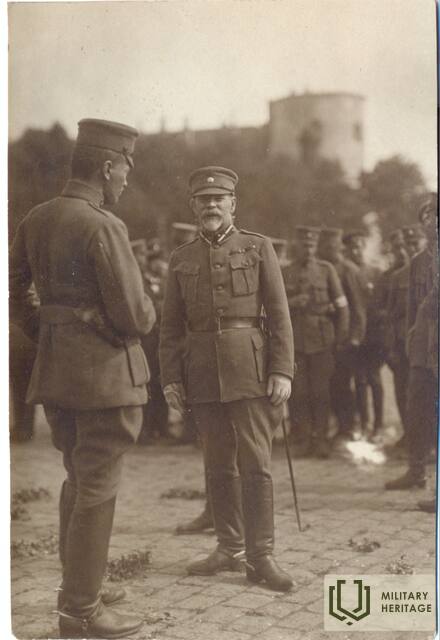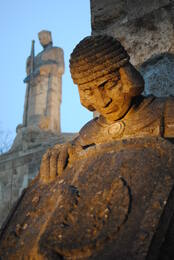Dāvids Sīmansons (1859–1933), Commander-in-Chief of the Latvian Army, Minister of Defense, General
I World War I, I Wars of Independence

Dāvids (also Dāvis) Sīmansons was born on March 23, 1859 (April 4, current date) in the Pīlātu half-manor of Valmiera parish. He graduated from Limbaži district school. In 1880, he joined the 115th Vyazma Infantry Regiment as a volunteer. In 1882, he graduated from the Infantry Junkers School in Riga. He studied at the General Staff Academy in St. Petersburg. He participated in the Russo-Japanese War. From 1910, he was a colonel. In April 1912, he was appointed commander of the 66th Infantry Regiment. From 1914, he participated in the battles of World War I against the German army in the territory of Poland, Lithuania and Latvia. In 1915, In May 1917, he was promoted to major general and appointed commander of the 2nd brigade of the 17th infantry division. He was awarded the orders of Stanislav I, III class, Anna III class, Vladimir III, IV class, and the sword of the Order of St. George. He left the service in October 1917. Until January 1919, he lived in Vitebsk and Oryol. He returned to Riga on January 8, 1919.
D. Sīmansons joined the Latvian Army on June 6, 1919, and from July 10, he was the Commander-in-Chief of the Army. From July 15 to September 10, he was the Minister of Security. On October 16, he was relieved of his post as Commander-in-Chief. In the summer of 1919, D. Sīmansons undertook the formation of the Latvian Army from units that were different in character and form, without sufficient supply and security, in conditions of general military and political confusion, when the Provisional Government in an only partially liberated country began to organize the state apparatus, which was hindered by many internal and external enemies. In this difficult situation, he also had to fulfill diplomatic functions in relations with foreign missions and the leadership of external armed forces, resolve the issue of the reorganization of the German Landeswehr into a unit of the Latvian Army, and others. He successfully fulfilled his tasks, laying an organizational and structural foundation for the Latvian Army.
For his intelligent and energetic actions during the Bermont attack on October 9-10, 1919, Dāvids Sīmansons was awarded the Lāčplēsis War Order, 3rd Class, in 1926.
From December 1920 he was a member of the Council of the Ministry of Defense (from 1922 – War). In 1924 he was appointed Acting Chairman of the Council of the Ministry of War. In February 1925 D. Sīmansons was discharged from the army due to illness. Dāvids Sīmansons died on 13 January 1933. Buried in Riga, at the Brāļu Cemetery.
A memorial plaque for David Simonsons was unveiled in 2014 in Limbaži near the former district school (sculptor Jānis Strupulis).
More information sources
Eriks Jēkabsons. David Simonsons. – National Encyclopedia: https://enciklopedija.lv/skirklis/29934-D%C4%81vids-S%C4%ABmansons
Biography of David Sīmansonas, Cavalier of the Lāčplēsis War Order: http://lkok.com/detail1.asp?ID=1402
Related timeline
Related objects
Brothers' Cemetery in Riga
Riga Brothers’ Cemetery is located in the northern district of Riga. The cemetery extends over an area of 9 ha and is the most outstanding and significant memorial ensemble in Latvia dedicated to the fallen Latvian soldiers. About 3,000 soldiers are buried here. The Brothers’ Cemetery was created during World War I after the first three Latvian Riflemen, who fell in Tīreļpurvs in the battle against the German Army, were buried here. Later Latvian soldiers who had died in other battles and wars would also be buried in the Brothers’ Cemetery. The memorial is based on the design of the sculptor Kārlis Zāle, and is the first memorial ensemble in Europe with such landscape, architecture and sculptural value. It uses elements typical to the Latvian landscape, traditional farmsteads, Latvian folklore and history that praise the characteristics of soldiers and tell the story of the way of the soldier. The memorial was unveiled in 1936 and it has three parts: ‘The Road of Though’ which is a 250 m long alley, ‘Terrace of Heroes’ with the Altar of the Sacred Flame and ensemble the Sacred Oak Grove, and the burial ground with the Latvian wall and a memorial of a mother with her fallen sons.
Related stories
About the first Commander-in-Chief of the Latvian Army, Dāvids Sīmansons
The essays in the book "Commanders of the Latvian Army" convince us that history is significantly influenced by specific individuals. Although they were at the epicenter of the most important historical events for a short time, true Latvian patriots, with their rich military experience, managed to do a lot in the formation and strengthening of the Latvian army and in the turning points of historical events.
This story is about the first Commander-in-Chief of the Latvian Army, Dāvids Sīmansons (1859-1933).






